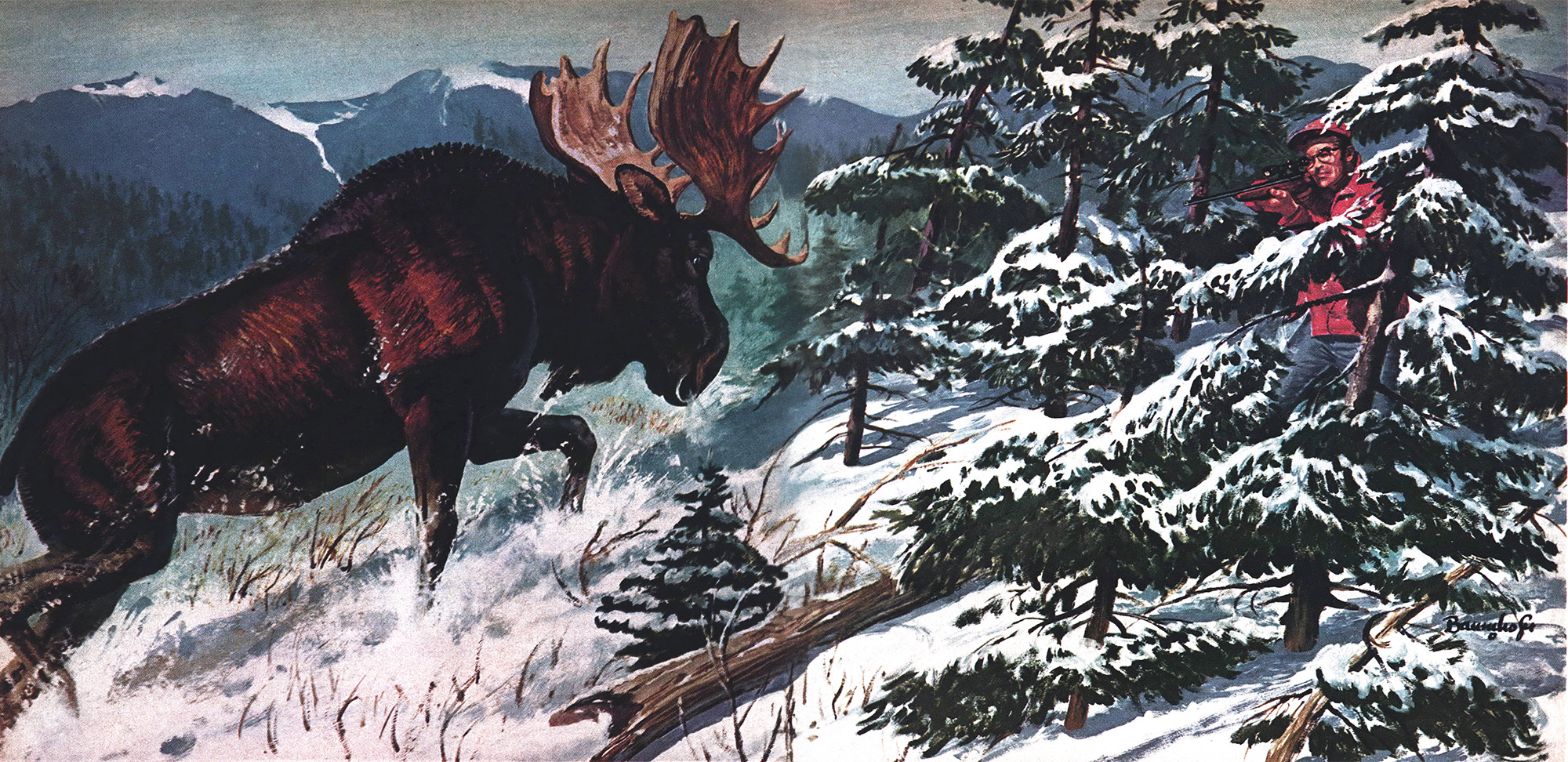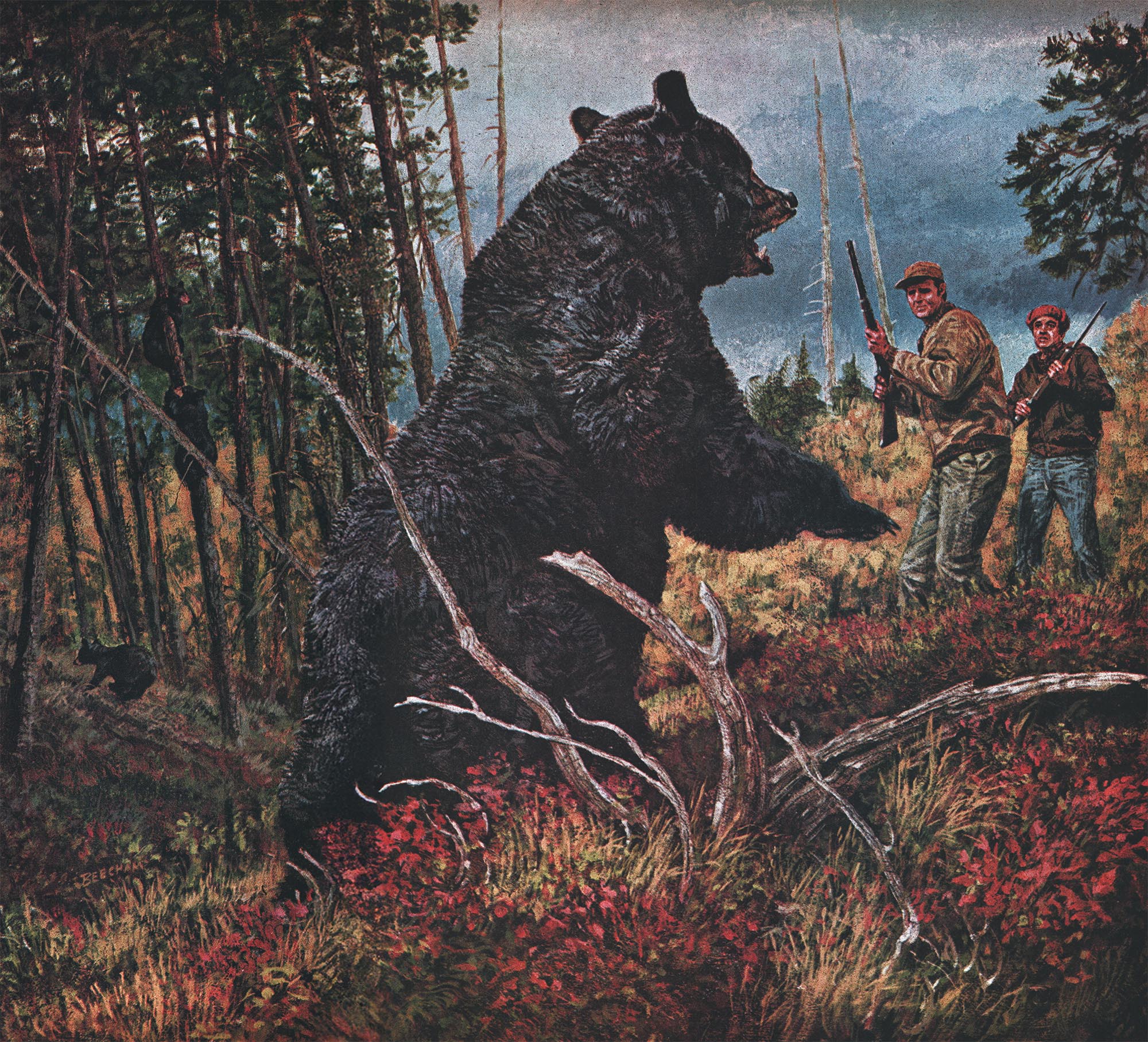Stories from Minnesota’s First Ever Moose Hunt

This story, “Minnesota’s First Moose Hunt,” appeared in the September 1972 issue of Outdoor Life.
“I HAD TO RUB my eyes before I could believe what I saw,” Paul Parks told me. “Moments before, I’d heard a twig snap,” he continued. “Then another twig broke and a thick branch cracked. Right after that, a big bull moose stepped out of a draw fifty yards below me. He was moving at a trot, and snow was flying from his hoofs. The odd thing was that he was coming up the snow covered ridge toward me.
“I was so surprised I stood as still as a stuffed owl. By the time I shouldered my Remington .270, the bull’s antlers looked six-feet wide. When I got him in my 2-to-7X Redfield scope, all I could see was hair.
“He was so close,” Parks continued, “that I decided I couldn’t miss his head, and I knew a bullet in the head wouldn’t ruin any meat. I held dead-center and touched off the first 130-grain Norma load. The bull didn’t even flinch. He kept coming straight at me as though nothing at all had happened. My second shot didn’t faze him either.
“I was fairly well concealed in a stand of small spruces. I’m sure the bull didn’t see me. He wasn’t charging. I think he was just determined to follow his chosen route. “By the time I was ready to fire the third shot, I knew I was in danger of being run over. That’s when a crazy thought flashed through my mind. I wondered how I had managed to get so close to a trophy moose. For two months, I’d tried desperately to get within rifle range of a decent bull, but in my wildest imaginings I had never wanted to be that close.”
Parks’ statements are even more dramatic when you know the background of his hunt. In the spring of 1971, Minnesota announced its first open season on moose in modern times, and Parks decided to apply for a permit. He is a plastic-mold maker in Hopkins, Minnesota, and had hunted deer and small game every fall for many years. But he had never had the opportunity to try for a moose.
He knew that chances of drawing one of the party permits for Minnesota’s first moose season in 49 years were slim, and he was more than surprised when he learned that his four-man group had been drawn. Only 400 party permits were issued for the 1971 hunt. The party-permit system had been stipulated by the state legislature when it authorized the moose season. Here is the way that it worked.
One moose (either sex, any age) could be taken by each four-man group. That arrangement allowed more hunters to participate. The total authorized kill was limited to 400 moose, so only 1,600 moose hunters would be in the woods. It was learned that 37,056 hunters had applied for permits.
Parks and his party — Bob Erickson, Walt Johnson, and Paul Ylitalo, all neighbors in Hopkins — ran out of luck in a hurry after they received their licenses. They hunted the first half of the split season, October 2-17, in wild country north and east of Isabella. They didn’t see a single moose. They didn’t even see fresh tracks.
Before the second half of the season, December 4-19, Parks and his partners did some scouting. A forest ranger told them the moose were working farther west of Isabella. Before dawn on the morning of the second opener while they were driving into their new hunting area, they spotted a big cow moose along the road. Their spirits soared.
Parks began hunting in a big cutover area among the ridges and draws along the Little Isabella River. He wasn’t more than two miles from the Boundary Water Canoe Area. Finally he decided to climb a ridge and watch for moose that might be moved by other hunters.
“I’d just settled down when a rifle roared three times,” he told me. “My first thought was that somebody was banging away at the cow we’d seen.
Nobody in my group wanted a cow. We had agreed that we weren’t going to blow the chance of a lifetime. If we couldn’t score on a decent bull, we wouldn’t score at all.
“I stood motionless because I figured the shooting might stir something up. There was three inches of snow on the ground, and the morning air was dead still. Moments later I heard that first twig snap. I thought the sound came from farther away than it did. That’s why I was so surprised when I saw the bull coming straight on only 50 yards away.
“When I fired my third shot, I was more interested in saving my neck than in killing a moose. I think that bullet missed the bull’s head, but the blast of the close range shot must have turned him. He swerved away from me, and I put the next bullet into his neck. The moose stumbled_once and then went down in a heap. He was dead when he hit the ground.
“My hair crawled when I checked him over. My first two shots had hit almost at point of aim. One had hit just above the animal’s nose. The other hit the side of the head. I guess they glanced off. They didn’t do much apparent damage. When I calmed down, I taped the bull’s antlers. The widest spread measured 47 inches.
“We had a prearranged signal in case anybody in our group killed a moose,” Parks went on, “so I fired two quick shots into the air to let the rest of the fellows know we had our bull. It wasn’t long before my three friends arrived. Believe me, we needed four men to turn that animal on his back so that we could gut him out.”
The big problem, after they had field dressed the bull, was to get the carcass back to the road and into Park’s pickup truck so they could register it at the Isabella checking station. A similar problem confronted almost all the successful moose hunters during Minnesota’s split season.
“I asked Bob Erickson to walk back to the pickup and get our meat saw so we could saw through the chest cavity,” Parks recalled. “I also asked him to check out a faint trail running along the ridge. I thought there might be a chance to drive the truck close to the bull.
“Well, Bob walked that old logging trail back to the road. He put chains on the pickup and drove it right up to my moose. We had a cable-ratchet hoist on the pickup, so we looped the cable around the moose’s antlers and hoisted the animal onto the truck. We were headed for home long before noon.”
So ended one success story made possible by the first Minnesota moose season since 1922.
The season was hailed by sportsmen and game officials as an outstanding success. Final figures showed that 93.5 percent of the four man hunting parties went home with a moose. Hunters bagged 374 animals out of a total of 1,430 that they spotted during both segments of the split season. As it turned out, 63.6 percent of the harvest consisted of adult bulls. Some of them were giants. The largest bull checked in had an antler spread of 56% inches, and the live weight was estimated to have been 1,500 pounds. That animal was killed just after dawn on the first morning of the October half of the season by Howard Dittmer of Green Isle.
Was the state’s moose population hit too hard?
“We’re sure we could have permitted a larger harvest,” said Roger Holmes, who is now supervisor of the game section of the Department of Natural Re sources. “We conducted an aerial census of the herd after the December portion of the season ended.”
When the state was first settled, moose were relatively common in most of its northern forests. Starting in the early 1900’s, most of Minnesota’s moose range was logged off. Much of it subsequently burned. With this change of habitat, the moose herd declined. Moose were seldom seen after the logging era ended. Hunting the big animals was outlawed in 1923. About that time, whitetail deer began increasing dramatically as the logged-over pine lands grew up in aspen, birch, maple, balsam, spruce, and other second-growth trees. In recent years, the second growth matured. Conditions for whitetails deteriorated because the overhead canopy formed by large trees prevented the growth of the low brush that is ideal deer habitat. Moose — mostly Canadian animals — moved back into the mature forest in great numbers.
Aerial-census work over the past 12 years showed that the state’s moose population fluctuated between 5,000 and 8,000 animals. That’s more than twice the number that ranged Minnesota in 1922.
“Our moose population is no longer increasing,” Roger Holmes told me. “It leveled off several years ago. This means that natural mortality is high. Research at the Agassiz National Wild life Refuge in the northwest part of the state indicates that the moose death rate is now equal to the high birth rate.”
Consequently, the Department of Natural Resources believed that a moose harvest by hunters could be substituted for a significant number of natural mortalities. In other words, hunters could and should take surplus animals that would otherwise die of starvation and other natural causes.
These included liver fluke, woodtick infestations, round worms in the brain, and lungworms, which cause “moose sickness.”
For several years the D.N.R. at tempted to persuade the Minnesota legislature to authorize a moose season to bring the herd down to the carrying capacity of the habitat. The 1971 legislature finally did so. It agreed to authorize a total kill of 400 animals, the number suggested by the D.N.R. as a reasonable harvest. Permits were is sued only to residents.
Setting up the hunt was a difficult and intricate task for game officials. Applications from 9,204 groups of four men each were received. Each one had to be checked to insure that facts were complete and accurate and that all applicants qualified as residents.
A computer was used to select the 400 lucky groups randomly. The successful groups had to wait nearly three weeks for confirmation while the D.N.R. checked for duplicate applications.
Of the 400 sets of license forms sent to successful parties, all but two were returned with the required notarized signatures and $100 license fee per party. Each man was then sent special moose-hunting regulations, zone maps, instructions on field-dressing, numbered back tags, bottles for moose-blood samples, and several other items.
All moose taken had to be registered and tagged at one of the seven check stations. The stations were manned by wildlife managers.
All hunters were asked to get a blood sample from each moose taken and to donate a tooth and a small tissue sample from the animal. During both segments of the season, game crews visited each kill site to col lect stomach samples and reproductive data from the internal organs of the animals.
All licensed hunters were required to stay in the zone for which they had a permit. They were also required to wear a red or fluorescent-orange outer coat, and to display their identifying back tags prominently.
Game officials expected hunting success to be high, especially in the northwestern zones. Those zones are relatively open and easily accessible, and they have the highest moose populations. As expected, hunting was best in Zone II, encompassing the Agassiz National Wildlife Refuge, and Zone III near the Twin Lake Wildlife Area at Karlstad.
There, 100 percent of the parties took moose. In Zone I around the Red Lake Wildlife Management Area near Baudette, 96.7 percent of the par ties scored. Success in the northeastern areas was as follows: Zone IV, 90 per cent; Zone V, 84.5 percent, and Zone VI, 83.6 percent.
“Those kill figures were most welcome,” Roger Holmes commented later. “The herd was badly in need of thinning, and the high percentages are evidence of quality hunting. Moreover, the split season allowed leisurely hunting. You could pick your moose if you hunted hard enough, and a lot of men did just that. Most hunters passed up the cows and calves. In the northwestern zones, moose were running all over the place. We heard of some hunting parties that saw over 20 moose in a few hours.”
One such party included Roger Halvorsen, a taxidermist from Fergus Falls; Walter Bergrud of Fergus Falls; and Harold and Dale Riggles, a father-and-son team from Cass Lake.
“I own some land up around the Agassiz National Wildlife Refuge northeast of Middle River,” Halvorsen told me. “We decided to hunt up there when we were lucky in the drawing. I had just returned from a moose hunt in northern Saskatchewan, but I never saw so many moose up there as we did in our own state while driving east of Middle River the night before the October opener.
“We saw 35 moose along and cross ing the roads that evening. We saw one bunch of 11 in a flax field. I wondered if they were so hungry that they had to eat flax stubble. We’d had five inches of rain before the season opened. Most of the flax fields and other low spots were flooded. There were moose trails all over that muddy country. Some of them looked like the trails you see near cattle barns.”
The next morning Halvorsen and his group were out at daybreak. Several of the big animals were still in the flax fields.
“I looked over twelve of them before I picked the one I wanted for a head mount,” Halvorsen continued. “I could have shot any one of several, but I waited to spot the best bull because we had lots of time to hunt.
“The one I selected crossed a road and disappeared into a flooded blueberry swamp. I followed him into the tangles. Somehow or another, I chased him back out. He was just about to go into an other flax field when I shot him with my Sako .30/06. I nailed him at two-hundred yards with one shot.
“All we had to do was back the truck up to him and load him on. It was a bit of a job getting the truck in there. The old concrete road was all broken up and just about abandoned.”
Halvorsen’s bull had an antler spread of 47 ½ inches, which nettled him a little. “His rack looked much bigger than it really was,” the hunter recalled, “but he dressed out at 940 pounds when we weighed him on the scales at Frank’s Mill back in Cass Lake. That’s a lot of moose meat, and we’re going to have some fine dinners for a long time.”
Dennis Weestrand, a building contractor in Plymouth, has a different type of story to tell. He dropped a bull with a 49½-inch rack way back in the boon docks of Zone IV between Kawishiwi and Perent lakes. Other members of the party were Weestrand’s brother Kenny, Norman Severson, and David Kolesar.
They drove a half-ton pickup and a four-wheel-drive jeep up to Tofte on the north shore of Lake Superior the day be fore opening day in October. They carried two 16-foot aluminum canoes atop the pickup. From Tofte they turned north up the Sawhill Trail.
“We took the canoes because we wanted to avoid the crowds everybody expected in Zone IV,” Weestrand said. “We figured we could get farther into the bush with the canoes.
“We drove within two miles of the Kawishiwi Lake Public Campground and then we put the canoes in where an old wooden bridge crosses Hog Creek. The creek flows through a bog that looked very moosey, so we paddled on down to Perent Lake with our equip ment and food and a plastic sheet for a makeshift tent. It was getting dark when we arrived at the opening into the lake. There we saw our first moose — a cow standing belly-deep in rushes.
“We had no interest in her. We’d agreed we would take nothing but a trophy bull, even if we had to come back for the December half of the season. We paddled out into the lake and camped that first night on an island near the mouth of Hog Creek.”
The next day was opening day, so the group paddled canoes around the shores of Perent Lake looking for moose.
In the late afternoon they found another party of moose hunters in camp on the north shore of the lake. One member of that party had shot a fair-size bull in a bog back of the lake.
The party was breaking camp to move out.
“I didn’t envy them,” Dennis told me. “They’d come in by boat with a 10-horsepower motor and had portaged around all the beaver dams in Hog Creek — dams we had just shoved our canoes over. They had two tents and a very elaborate outfit.”
Before dark Weestrand’s party scout ed a few of the logging trails behind their campsite. The next morning they had breakfast before daylight, put some salami sandwiches and chocolate bars into their pockets, and set out for the day. Each man took a different logging road into the wilderness north of their camp.
The group met for lunch and then went out again in the afternoon. Norm Severson and Weestrand took up stands on stacks of pulpwood. Finally Wee strand decided to hike down a trail.
“Then I saw this fellow in a red vest walking through heavy balsam and as pen woods,” he recalls. “He looked like my brother Kenny. I got nervous be cause Kenny was supposed to be down near our camp. I told Norm I would check the hunter out and see what was going on.
“I went over there and recognized one of the hunters we had met at the elaborate camp. He was hiking out to his vehicle, and he had so much moose meat in a packsack that he couldn’t go any farther. He was waiting for one of his friends to catch up and help him.
“I talked with him a while,” Wee strand told me, “and then went off the trail and climbed a hill. When I topped out, I saw a cow moose feeding below me. Then something happened that really threw me. I could hardly believe it when I saw a car coming toward me along an old logging trail. A game warden got out of the vehicle, looked at the cow, and asked why I didn’t shoot her. I told him I didn’t want a moose without antlers.
“Well, the warden went over to his car, turned on his radio, and talked with another warden who was up above in an airplane. Then he drove off along the trail that looked rough enough to shake his car apart. It really upset me to know that a car could get into that wild country. I didn’t learn till later that game wardens and other officials had authority to drive along some logging roads and trails that are closed to the public.
“I sat down and watched the cow for a while. Then I heard a commotion approaching in nearby thickets. I stared until my eyes felt ready to fall out of their sockets. About 100 yards away, I spotted a moose antler moving in a thick stand of balsams. I could see only one antler. It kept bobbing up and down. ‘That bull has only one antler’, I said to myself. I wasn’t going to shoot a freak.
“I kept on staring at the strange sight. Suddenly the other antler came into view. I waited to see if the bull would come any closer because I wanted a clear shot. The wind was right, from him to me. He kept fussing around in the thickets, and I figured if I waited much longer, I wouldn’t be able to see him at all.
“I raised my rifle and found his antlers in my 4-to-9x scope. With the scope, I could dimly make out where his neck was, and I squeezed off a 220-grain load from my .30/06 bolt-action Winchester. “The shot sounded very loud in the stillness. The moose simply sank down out of sight. Then I heard him take a couple jumps into the bush, and every thing was quiet again till Norm came rushing up.”
Both hunters went into the thicket and found the bull stone-dead with a bullet hole through neck and throat. They gutted him out and propped him on the side of a little rise so the blood would drain. Then they cut off a big slice of neck meat and began an hour’s hike back to camp. Everybody in the group agreed later that nothing had ever tasted better than their evening meal of fried moose meat.
ext morning they broke camp be cause the dead bull was nearer the vehicles than it was to their campsite. They took their two canoes and went back up Hog Creek to the pickup truck and jeep. Then they drove to the Kawishiwi Lake campgrounds and hiked down a logging trail to their moose. A team of game-department field men was already at the site, taking their samples for the departmental survey.
The hunters learned that someone was logging in the vicinity. They walked to the logging site and asked the driver of a log loader if he would pull their moose out for them with his machine.
There was some hesitation because of restrictions on motorized travel in the Boundary Water Canoe Area, but the man agreed to do the job after the state field men assured him the carcass was just outside the area’s boundary.
“The loading arm of that huge machine picked up our moose by the neck and lifted it nine feet into the air,” Weestrand told me. “About 1,000 pounds seemed like nothing. But when the loading arm was raised as high as it would go, the animal’s hind legs were still dragging on the ground. We had to struggle to get the legs into the pickup first. A logging chain and four pairs of strong arms accomplished that task.
“We saw seven moose during our three days in the bush. Six of them were cows or yearling bulls still with their mothers. We didn’t want any of them. The seventh one was the bull I shot.”
Read Next: My Buddy and I Got Lost on a Caribou Hunt. I Survived, But He Didn’t
What’s next for Minnesota moose? “We’re going to ask the legislature for authority to have another season in 1973,” said Dave Vesall, assistant director of the Minnesota Division of Game and Fish. “We’d ask for a season in ’72 except that the state legislature meets only once every two years. They won’t meet again till 1973.
“Next time we’ll ask authority to have a moose season every year until our herd is brought into balance with the holding capacity of available habitat.”
Read the full article here









